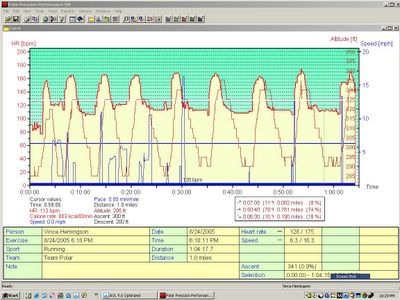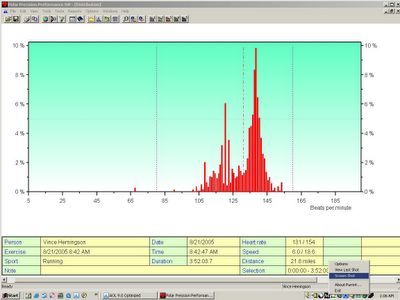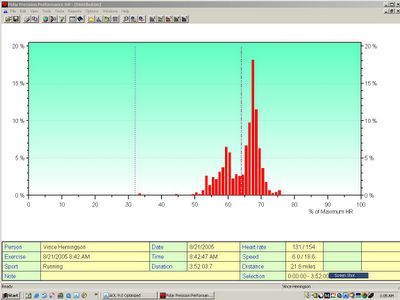It's just like clockwork. There are significant numbers of people who move up from the 10K Clinic to the Half Marathon Clinic and those who graduate from the Half Marathon Clinic to the full Marathon Clinic that exhibit some form of "shin-splint" or calf pain symtoms just before the halfway point of the clinics. This is more common on athletes making significant increase in speed and especially mileage for the first time. For these people, it's undiscovered country. I adressed the concerns of those folks last weeks.
Now comes the "band" people. And hopefully it won't be the "Last Waltz" for them. As we ramp up mileage, speed and workout load, it is generally some of the more seasoned athletes who get twinges in their ITBs. In fact two of the most talented athletes I run with are just on the edge.
So without further ado, here are three of the best articles I could find on the subject.
http://www.thestretchinghandbook.com/archives/knee-pain.htmKnee Pain, Knee Injuries andIliotibial Band SyndromeA Guide to the Treatment and Preventionof Knee Injuries and Iliotibial Band Syndrome!Knee pain and knee injuries, as a result of Iliotibial Band Syndrome, can be an extremely painful and frustrating injury that puts a big strain on both the knee and hip joints.
Knee injuries are very common among runners and cyclists. However, they doesn't usually occur in an instant, like a hamstring strain or groin pull, but commonly starts off as a twinge or niggle, and progress quickly to a debilitating sports injury that can sideline the best of us for weeks.
For those who aren't familiar with Iliotibial Band Syndrome, let's start by having a look at the muscle responsible for the problem.
The iliotibial band is actually a thick tendon-like portion of another muscle called the tensor fasciae latae. This band passes down the outside of the thigh and inserts just below the knee.
The diagram to the right shows the anterior (front) view of the right thigh muscles. If you look towards the top left of the diagram, you'll see the tensor fasciae latae muscle. Follow the tendon of this muscle down and you'll see that it runs all the way to the knee. This thick band of tendon is the iliotibial band. Or iliotibial tract, as it is labelled in the diagram.
The main problem occurs when the tensor fasciae latae muscle and iliotibial band become tight. This causes the tendon to pull the knee joint out of alignment and rub against the outside of the knee, which results in inflammation and pain.
CausesThere are two main causes of knee pain associated with iliotibial band syndrome.
The first is "overload" and the second is "biomechanical errors."Overload is common with sports that require a lot of running or weight bearing activity. This is why ITB is commonly a runner's injury. When the tensor fasciae latae muscle and iliotibial band become fatigued and overloaded, they lose their ability to adequately stabilize the entire leg. This in-turn places stress on the knee joint, which results in pain and damage to the structures that make up the knee joint.
Overload on the ITB can be caused by a number of things.
They include:
Exercising on hard surfaces, like concrete;
Exercising on uneven ground;
Beginning an exercise program after a long lay-off period;
Increasing exercise intensity or duration too quickly;
Exercising in worn out or ill fitting shoes; and
Excessive uphill or downhill running.
Biomechanical errors include:
Leg length differences;
Tight, stiff muscles in the leg;
Muscle imbalances;
Foot structure problems such as flat feet; and
Gait, or running style problems such as pronation.Immediate TreatmentFirstly, be sure to remove the cause of the problem. Whether is be an overload problem, or a biomechanical problem, make sure steps are taken to remove the cause.The basic treatment for knee pain that results from ITB Syndrome is no different to most other soft tissue injuries. Immediately following the onset of any knee pain, the R.I.C.E.R. regime should be applied. This involves Rest, Ice, Compression, Elevation, and Referral to an appropriate professional for an accurate diagnosis. It is critical that the R.I.C.E.R. regime be implemented for at least the first 48 to 72 hours. Doing this will give you the best possible chance of a complete and full recovery.Ongoing Treatment and PreventionAlthough the pain may be felt mainly in the knee, the problem is actually caused by the muscles that support the knee. Namely the tensor fasciae latae and the large muscle at the rear of your upper leg, called the gluteus maximus.Other muscles in the lower back, hip, backside and upper leg also affect the function of the knee, so it's important to pay attention to all these muscles. After the first 48 to 72 hours, consider a good deep tissue massage. It may be just what you need to help loosen up those tight muscles.Firstly, don't forget a thorough and correct warm up will help to prepare the muscles and tendons for any activity to come. Without a proper warm up the muscles and tendons will be tight and stiff. There will be limited blood flow to the leg muscles, which will result in a lack of oxygen and nutrients for those muscles.Before any activity be sure to thoroughly warm up all the muscles and tendons that will be used during your sport or activity. For a detailed explanation of how, why and when to perform your warm up, visit
h
ttp://www.thestretchinghandbook.com/archives/warm-up.htm.
Secondly, flexible muscles are extremely important in the prevention of most leg injuries. When muscles and tendons are flexible and supple, they are able to move and perform without being over stretched. If however, your muscles and tendons are tight and stiff, it is quite easy for those muscles and tendons to be pushed beyond their natural range of movement.
The stretch to the left is one of the best stretches for the tensor fasciae latae.
Stand upright and cross one foot behind the other. Then lean towards the foot that is behind the other. Hold this stretch for about 15 to 20 seconds, and then repeat it 3 to 4 times on each leg.
To keep your muscles and tendons flexible and supple, it is important to undertake a structured stretching routine. For a comprehensive reference of over 100 clear photographs of every possible sports related stretch, you can't go past The Stretching Handbook. If you're interested in stretches for the upper legs, hips and backside, The Stretching Handbook has detailed photographs of 36 different stretches you can do.
Order your copy now!And thirdly, strengthening and conditioning the muscles around your knee and upper leg will help greatly to reduce the chance of knee injury and knee pain.
If you are in too much pain to resume normal exercise, consider swimming,
deep water exercise, or maybe cycling. Otherwise, the following web site,
http://www.thewalkingsite.com/knees1.html has a list of simple, easy strengthening exercises for the muscles of the upper leg and knee. To keep your knees in tip-top condition practice these regularly.
If you enjoyed this month's issue of The Stretching & Sports Injury Newsletter, please feel free to forward it to others, make it available for download from your site or post it on forums for others to read.
Please make sure the following paragraph and URL are included.
-----------------------------------------------------------
Article by Brad Walker. Brad is a leading stretching andsports injury consultant with over 15 years experiencein the health and fitness industry. For more articles onstretching, flexibility and sports injury, subscribe toThe Stretching & Sports Injury Newsletter by visiting
http://www.thestretchinghandbook.com/newsletter.htm.
-----------------------------------------------------------
http://sportsmedicine.about.com/cs/knee_injuries/a/aa021401.htmIliotibial (IT) Band Friction SyndromeThe iliotibial (IT) band is a tough group of fibers that run along the outside of the thigh. It begins at the hip and extends to the outer side of the shin bone (tibia) just below the knee joint. Iliotibial band syndrome is due to inflammation of this band. The IT band acts primarily as a stabilizer during running and may become irritated from overuse. The pain is generally felt on the outside (lateral) aspect of the knee or lower thigh, and is often more intense when descending stairs, or getting up from a seated position.
CausesIt band friction syndrome is often predisposed by overuse, training errors or faulty biomechanics. It is more common in runners than other athletes and may be linked to running only on one side of a crowned road.Because most roads slope off to the sides, running in the same direction leads to the outside foot being lower than the inside foot. This in turn, causes the pelvis to tilt to one side and stresses the IT band. The biomechanical abnormalities that may lead to IT band problems include: excessive
pronation of the foot, leg length discrepancy, lateral pelvic tilt, and "bowed" legs. Muscle tightness or lack of flexibility in the gluteal or quadriceps muscles may exacerbate IT band injuries.
Many physical therapists use Video tape analysis to uncover such biomechanical problems.
TreatmentTreating IT band friction syndrome includes:
R.I.C.E.. Rest, ice, compression and elevation as needed. It is also important to address any biomechanical or training errors, and perform flexibility exercises. (see below).
Proper
footwear is also an important factor of treatment and prevention. Reducing mileage and being alert to the signs of
overtraining syndrome can help you identify potential risk factors in your personal training style.
If you have an IT band friction injury, you will need to rest in order for the inflammation to decrease. This rest, along with a low-impact cross-training activity can lead to a faster recovery. Anti-inflammatory medications (
NSAIDS may also be prescribed by your doctor to reduce painful inflammation.
PreventionPrevention of the IT band syndrome consists of the following:
Proper Strengthening Exercises Strengthening the external hip rotators may also help reduce the risk of IT Band injuries. The best exercise is doing sets of one leg squats in front of a mirror. Make sure your pelvis does not drop on one side.
Proper Stretching ExercisesHow To Stretch The IT BandCross your right leg over your left leg while standing, and extend your left arm against a wall, pole, chair or other stable object. Lean your weight against the object while pushing your right hip in the opposite direction. Keep your right foot anchored while allowing your left knee to flex. You should feel the stretch in the iliotibial muscle in your right hip and extending down the outside of your right leg.Selecting Proper Footwear
Orthotics may also help for chronic IT band inflammation. (See
Foot Facts).
Avoiding
OvertrainingCross trainingAllowing plenty of rest and recovery in the training program.
Running on a soft, level surface or alternating directions on the road
IT Band Friction Syndrome does not have to be a chronic, or debilitating problem. A little bit of prevention and careful diagnosis of the cause can lead to a complete and full recovery.http://www.time-to-run.com/injuries/thebig5/itb.htmITB - iliotibial band syndrome - the BIG 5 - common running injuries
Iliotibial Band SyndromeDefinition: Pain and inflammation on the outside of the knee, where the iliotibial band (a muscle on the outside of the thigh) becomes tendinous, and results in a friction syndrome by rubbing against the femur (thigh bone) as it runs alongside the knee joint.
Symptoms:Initially, a dull ache 1-2 kilometres into a run, with pain remaining for the duration of the run. The pain disappears soon after stopping running, later, severe sharp pain which prevents running pain is worse on running downhills, or on cambered surfaces pain may be present when walking up or downstairs.Local tenderness and inflammation
Causes:Anything that causes the leg to bend inwards, stretching the ITB against the femur overpronation (feet rotate too far inward on impact) tightness of the ITB muscle lack of stretching of the ITB incorrect or worn shoes excessive hill running (especially downhills) and running on cambered surfaces overtraining .
Self-treatment:Stop running, especially in the case of severe pain if pain is mild, then reduce training load and intensity, and avoid downhill running and running on cambered surfaces.
Take a course (5 - 7 days) of non-steroidal anti-inflammatory drugs (ibuprofen/voltaren/cataflam/mobic) available from your general practitioner or pharmacist.
Apply ice to the knee (for 10minutes every 2 hours) in order to reduce the inflammation
Self-massage, using arnica oil or an anti-inflammatory gel, to the muscle only (along the outside of the thigh). Do not massage the side of the knee where you feel the pain, as this will only aggravate the friction syndrome stretching of the ITB.
Stand with the right leg crossed in the back of the left leg. Extend the left arm against a wall/pole/chair/other stable object. Lean your weight against the object while pushing your right hip in the opposite direction. Keep your right foot anchored while allowing your left knee to flex. You should feel the stretch in the ITB muscle in the right hip and along the outside of the right thigh. Hold for 30 sec. Relax slowly.Repeat to opposite side. Repeat stretch 2 - 3 times per day.
Remember to stretch well before running
Return to running gradually
Full recovery is usually between three to six weeks
Medical treatment: Physiotherapy, if injury doesn't respond to self-treatment in 2 to 3 weeks
Orthotist or podiatrist for custom-made orthotics to control overpronation
Orthopaedic surgeon - if injury does not respond to physiotherapy treatment, a cortisone injection into the ITB, or surgery to release the ITB may be indicated.
Alternative exercises:Swimming, pool running, cycling (in low gear) "spinning" Avoid any exercise that places strain onto the ITB, specifically, avoid stair-climbing
Preventative measures:Stretching of the ITB, quadriceps, hamstring, and gluteal muscles. Hold each stretch for 30 seconds, relax slowly. Repeat stretches 2 - 3 times per day.
Remember to stretch well before running.
Strengthening of quadriceps, hamstring and calf muscles.
Correct shoes, specifically motion-control shoes and orthotics to correct overpronation
Gradual progression of training programme
Avoid excessive downhill running, and cambered roads (stay on the flattest part of the road)Incorporate rest into training programme !



























